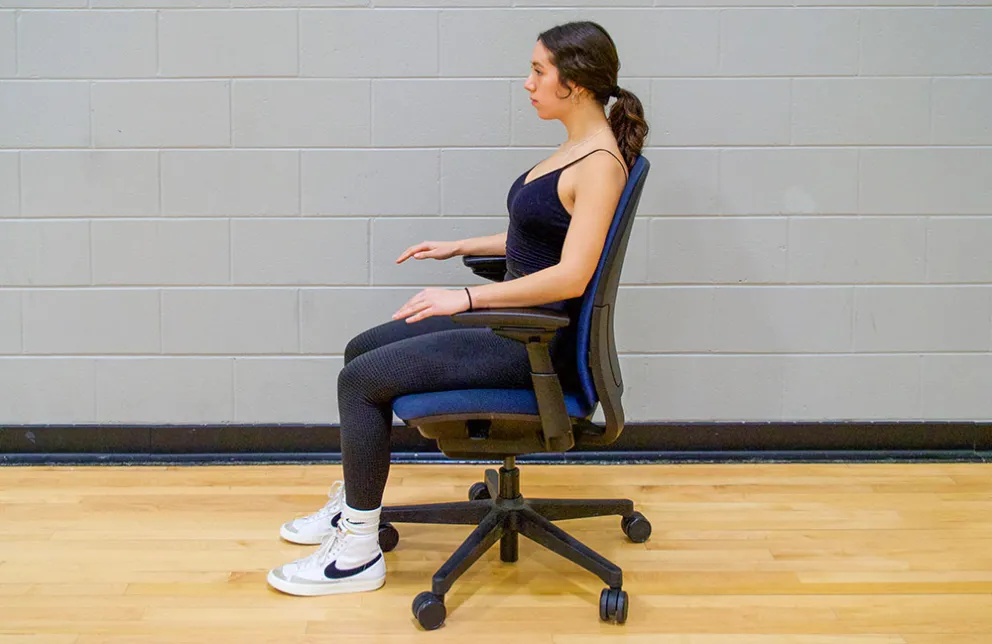
UPAA Blog 2021-22 #15 - 3/24/22 (photos and text by Heather Gulgin, photo above by Matt Cashore)
Heather Gulgin is a professor of exercise science at Grand Valley State University. She conducted a study of photographers and how they work and move. The UPAA blog is no substitute for professional medical consultation (Uh, obviously!) but the suggested stretches shown in this article may help on those long days when the Alleve has worn off and the aches and pains are getting ache-ier and pain-ier. -Ed.
************
Little is known about the occupational characteristics of how professional photographers function or perform their work on day-to-day basis. In particular, there is no research that has surveyed photographers to inquire if they experience pain/injury as a result of the demands of their profession.
A professor of Biomechanics and Exercise Science at Grand Valley State University was interested in gathering this information and conducted a survey study. Participants were asked about the type of camera used (full-frame or smaller), number of cameras carried, how much camera and lighting equipment weighs, how they carry camera and lighting equipment, whether they use a tripod/monopod, type of grip posture used, hours spent sitting for post-editing, as well as any pain/injuries experienced.
110 professional photographers responded:
•73% had 16+ years of experience in the profession
•70% carry two cameras on assignment
•75% carry between 11-30 lbs. of camera equipment
Lighting gear is an additional load:
•45% carry 11-30 lbs.
•30% carry 40+ lbs.
Participants could choose more than one option on how carry camera equipment resulting in:
•63% over shoulder
•44% backpack
•38% rolling bag
•20% belt pack
The most widely used cameras were full-frame (93%) which require larger, heavier lenses than other cropped sensor systems. Interestingly, 44% have changed equipment in the past, and another 13% are considering, with likelihood of moving toward lighter weight system.
The top three shooting assignments were onsite event (39%), portrait onsite (29%), and sports (25%). The use of tripod or monopod when on assignment was 22%, and the average time spent sitting for post-editing was 24 hours/week. The most predominant hand grips used were A (45%) and E (44%).

Photography is an industry that requires repetitive, fixed positions to complete the necessary occupational tasks. This study has reported numerous data that provides important information for professional photographers to better understand the factors that may contribute to overuse musculoskeletal injuries. Self-reported pain was most evidenced in the low back (78%), shoulder (68%), and neck (65%). Given the demands of the job and the amount of musculoskeletal pain experienced, photographers may benefit from adding stretches and strengthening exercises for these body regions. Additionally, being aware of the typical grip postures utilized, carrying methods for equipment, amount of time spent sitting for post-editing, and other factors may allow the photographer to self-modify for prevention of pain or overuse injury. Interestingly, the time spent sitting post-editing (24 hrs/week) equates to approximately half of their work week. Thus, using correct posture when sitting, reducing the time spent in the same fixed postures, and taking breaks throughout day to stretch may help reduce neck and back pain.
In summary, based on the number of professional photographers that have experienced neck, back, and shoulder pain, it would be beneficial to incorporate stretches and strengthening exercises throughout the day, explore various hand grips and equipment transport methods that may eliminate excessive loading, and consider use of a standing work-station instead of prolonged sitting.
Additionally, here are some illustrated examples of stretching and strengthening exercises:
To maintain proper sitting posture
Check the following: shoulders relaxed, back supported (may add lumbar roll to support lumbar curvature), arms supported (bent at elbow 90 degrees), thighs horizontal to ground (adjust seat height), feet flat on floor, head upright aligned over hips (avoid protruding head forward).

Correct sitting posture
To help maintain overall posture
Corner stretch: Find a corner, place hands on side walls with elbows about shoulder height. Lean into corner until feel stretch through chest and front of shoulders. Hold 10 seconds. Repeat 3 times.

Corner stretch
Shoulder blade (scapula) squeeze: Raise arms out to side until elbows about shoulder height. Squeeze shoulder blades together (toward spine). Hold 3 seconds. Repeat 10 times.

Shoulder blade squeeze end position – back
To strengthen low back
Superman lift-off exercise: Lift up and hold 10 seconds. Return to relaxed position. Repeat 5 times.

Superman lift-off
To stretch low back
Prayer stretch: Hold 10 seconds in each position (left, middle, right). Repeat 3 times.

Prayer stretch
Cat cow stretch: Start in cat position, hold 3 seconds, go to cow position, hold 3 seconds. Repeat 5 times.

Left, cat position, right, cow position
To stretch neck
Sidebend: Use one hand to sidebend head one direction until feel stretch on opposite side of neck. Hold 5 seconds. Repeat 3 times on each side.

Sidebend stretch
Forward: Use one hand to pull head forward, tucking chin to chest until feel stretch in back of neck. Hold 5 seconds. Repeat 3 times.

Neck flexion stretch
Chin tucks: Start with neutral head posture. Use two fingers to push your chin straight backwards (will feel slight stretch in back of neck). Once familiar with movement, try without use of fingers. Hold 3 seconds. Repeat 5 times.

Chin tuck start position, chin tuck end position
For shoulder: Carrying equipment may already overwork trapezius muscles (that shrug shoulders), so best to focus on distributing the weight equally (backpack style), or switching the shoulder you carry equipment with and keep up with scapula stabilizing exercise (squeeze shoulder blades toward spine).
************
"What does 'IDK' stand for? I've asked a lot of people but no one seems to know." Thanks for reading the blog. Contributions & feedback are welcomed and encouraged. Contact editor Matt Cashore mcashore@nd.edu. Follow UPAA on Instagram!